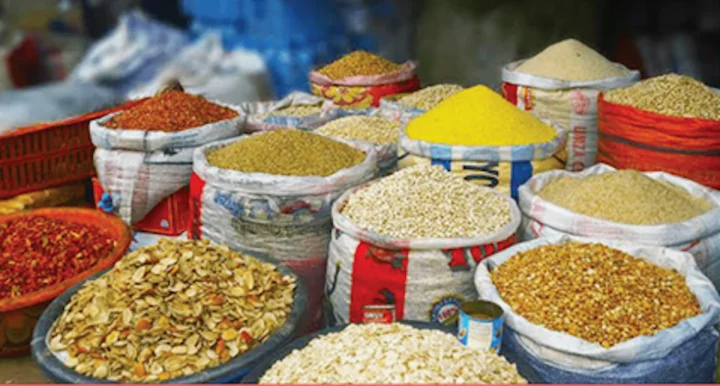SB Morgen (SBM) Intelligence, a geopolitical research firm, says soaring inflation, increased energy costs, and fluctuating foreign exchange (FX) rates caused a hike in the cost of food items in West Africa between October 2023 and March 2024.
The research firm, in its latest report, titled, ‘Jollof Index Q1 2024: Crisis at the Table’, explained food inflation in Nigeria by using a delicacy that is common to many households — jollof rice.
The index covers major food items used in making a pot of jollof rice; such as rice, curry, thyme, seasoning, groundnut and vegetable oil, turkey and chicken, beef, pepper, tomatoes, salt, and onions.
SBM said among the West African English-speaking countries, Nigeria experienced one of its worst food crises — with food inflation rising from 31.51 percent in October 2023 to 40.1 percent in March 2024.
Advertisement
“This increase was primarily driven by the depreciation of the Naira, which reached an all-time high of over N1,600 to a dollar in March 2024, affecting the prices of imported food,” the report said.
“Other long-standing issues, such as conflicts in food-producing regions, reduced arable land, climate variability, increased energy costs, and restrictions on foreign exchange for certain food items, contribute to rising food prices.
“In contrast, Ghana saw a substantial reversal in food inflation during the same period, decreasing from 44.8% in October 2023 to 29.6% in March 2024. Nevertheless, food inflation remains a significant problem in the country.”
Advertisement
The report also measured the national average cost of making a pot of jollof rice across the 13 markets in the six geopolitical zones of Nigeria.
During the period examined, according to the data, the average cost of preparing a pot of jollof rice rose from N13,106 to N16,955, representing a 29.3 percent surge.
Highlighting the impact of food inflation on Nigerian households by states, the report said Onitsha market experienced the highest percentage increase at 44.9 percent, with the cost of preparing jollof rice rising from N10,280 to N14,900.
“This substantial increase in Onitsha, previously the most affordable market, underscores the pervasive nature of food inflation affecting all regions. Port Harcourt and Balogun markets also witnessed significant increases of 38.5% and 38.4% respectively,” SBM added.
Advertisement
“The prices in these markets rose from N12,850 to N17,800 in Port Harcourt and from N12,500 to N17,300 in Balogun, indicating the challenges faced by consumers in urban areas.
“The Trade Fair market in Lagos saw a 37.8% increase, with the cost of preparing jollof rice climbing from N12,550 to N17,300.
“Similarly, the Dugbe market in Ibadan experienced a 32.7% rise, with prices increasing from N11,770 to N15,620. Calabar Municipal market recorded a 32.6% increase, with the cost of jollof rice from N12,950 to N16,550.
“The data clearly illustrates Nigeria’s worsening food inflation crisis, with all markets experiencing substantial price increases.”
Advertisement
SBM said the rising cost of preparing a staple dish like jollof rice highlights Nigerian families’ growing challenges in meeting their basic food needs.
The situation, the research firm said, calls for urgent interventions and policies to address food affordability and alleviate the burden on households across the country.
Advertisement
The company said all four markets experienced the most significant price increases (on a month-on-month basis) between October and November 2023 and from January to February 2024.
“The factors contributing to these sharp increases are the same in other locations, including the rising costs of key ingredients, such as seasoning, beef, turkey, and rice,” SBM added.
Advertisement
“As mentioned in addition to a weak Naira, transportation challenges and supply chain disruptions account for this trend.”
In addressing the food crisis in Nigeria, SBM urged the federal government to resolve the ongoing conflicts and transition to mechanised agriculture.
Advertisement
LIKE NIGERIA, COST OF MAKING GHANA JOLLOF RICE SURGES
In its report, SBM said the cost of preparing Ghana jollof rice also increased within the period under review.
“[The] index reveals a significant upward trend in the cost of preparing a pot of jollof rice for a family of five in Ghana over the six months,” the report said.
“Within six months, from September 2023 to February 2024, the cost of preparing a pot of jollof rice in Ghana increased by a staggering 43.0%.”
This significant increase, the firm said, contrasts with the relative stability observed in the previous year and highlights the intensifying food inflation crisis in the country.
Add a comment






